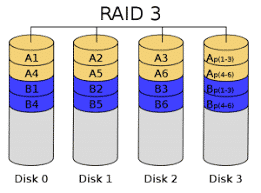What are the benefits of using raid 3 in a backup application
Definition – What is the meaning of RAID 3?
RAID 3 is a type of Raid (Redundant Array of Independent Disks) that strips the byte level and store dedicated parity bits on another distinguished drive. Just like RAID 2, RAID 3 must have a special controller that enables synchronized spinning of all the disk drives. Instead of just striping data blocks onto separate disk drives, RAID 3 stripes the bits, which are then stored on different disk drives. This type of configuration is used less often than other RAID levels.
Raid 3 Explained.
Since RAID 3 puts together striping & parity with stored parity bits on an assigned disk, this configuration involves at least 3 individual hard disks – 2 for striping data and 1 for saving parity bits. The disks must be able to spin in sync, so constant read/write (R/W) function establish good performance. However, random R/W functions may take heavy hits in performance.
In real terms, the read speed is way greater than write speeds. reason is it requires checksum calculations, which is a performance hindrance for the entire disk array.
Advantages of Raid 3 include:
- It has high capability to transfer huge amounts of data
- Proof against to disk failure & malfunction.
Disadvantages of Raid 3
- Disk failing are likely to reduce.
- Disk failures may crucially decrease output.


